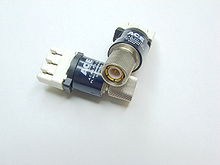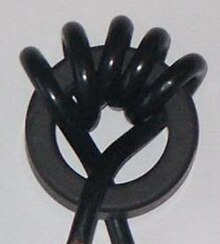This is an old revision of this page, as edited by 207.195.86.230 (talk) at 06:23, 4 December 2022 (→Balun transformer type). The present address (URL) is a permanent link to this revision, which may differ significantly from the current revision.
Revision as of 06:23, 4 December 2022 by 207.195.86.230 (talk) (→Balun transformer type)(diff) ← Previous revision | Latest revision (diff) | Newer revision → (diff)For other uses, see Balun (disambiguation).
| This article includes a list of general references, but it lacks sufficient corresponding inline citations. Please help to improve this article by introducing more precise citations. (October 2008) (Learn how and when to remove this message) |

| Part of a series on |
| Antennas |
|---|
 |
| Common types |
| Components |
| Systems |
| Safety and regulation |
| Radiation sources / regions |
| Characteristics |
| Techniques |
A balun /ˈbælʌn/ (from "balanced to unbalanced", originally, but now dated from "balancing unit") is an electrical device that allows balanced and unbalanced lines to be interfaced without disturbing the impedance arrangement of either line. A balun can take many forms and may include devices that also transform impedances but need not do so. Sometimes, in the case of transformer baluns, they use magnetic coupling but need not do so. Common-mode chokes are also used as baluns and work by eliminating, rather than rejecting, common mode signals.
Types of balun
Balun transformer type

The simplest isolation transformer has two electrically separate windings of wire coils wound around a core. An isolation transformer can eliminate ground loops or accomplish a number of other things such as biasing, summing or other mathematical operations such as mixing, multiplying, or converting.
There are two commonly used configurations of balun transformer, a simple current balun that requires a load in order to induce a flux in the core, and a slightly more complex voltage balun that self induces a flux through a third coil to produce differential signals that are less load dependent. The core that they are wound on may either be anything similar to that found in a regular inductor or transformer. Although the electrical coupling and magnetic field theory follows the same principles of transformer theory, the primary and secondary coils are shared to produce a balanced/differential signal pair that reference the same ground as the unbalanced input.
A current balun might find purpose with a number of current sensing circuits, while a voltage balun might be an optimal choice for voltage amplifiers. Both types will produce some amount of imbalance due to core losses, and the optimal choice for any given application requires an extensive analysis of the balanced load.
Autotransformer type

An ideal balun consists of two wires (primary and secondary) and a core: the current in the primary wire generates a magnetic field in the core, which in turn induces an electric field in the secondary wire. An autotransformer balun has only one coil, or is made of two or more coils that have an electrical connection, wound around a core. One can also make an autotransformer from an ordinary transformer by cross-wiring the primary and secondary windings. Baluns made with autotransformer windings are also called voltage baluns, since they produce balanced output voltage, but not necessarily balanced current.

In all autotransformers, the single winding must have at least one extra electrical connection – called a tap or tap point – between the two ends of the winding. The current sent into the balun through one pair of connections acts as if it were a primary coil, and magnetizes the entire core. When the electric current in the input segment of the coil changes, the induced magnetic field collapses and the collapse of the magnetic field in the core induces an electric current in the entire coil. Electrical connections to parts of the coil different from the input connections have higher or lower voltages depending on the length of the coil that the output is tapped from.
Unlike transformer-type baluns, an autotransformer balun provides a path for DC current to ground from every terminal. Since outdoor antennas are prone build-up of static electric charge, the path for the static to drain to ground through an autotransformer balun can be a distinct advantage.
Transmission-line transformer type
Transmission line or choke baluns can be considered as simple forms of transmission line transformers. This type is sometimes called a current balun, since it ensures equal current on both sides of its output, but not necessarily equal voltage. These are normally called ununs, because they go from unbalanced to unbalanced or un-un. Baluns are balanced to unbalanced or bal-un.

A more subtle type results when the transformer type (magnetic coupling) is combined with the transmission line type (electro-magnetic coupling). Most typically the same kind of transmission line wires are used for the windings as carry the signal from the radio to the antenna, although these baluns can be made using any type of wire. The resulting devices have very wideband operation. Transmission line transformers commonly use small ferrite cores in toroidal rings or two-hole, binocular, shapes.
The Guanella transmission line transformer (Guanella 1944) is often combined with a balun to act as an impedance matching transformer. Putting balancing aside a transformer of this type consists of a 75 Ω transmission line divided in parallel into two 150 Ω cables, which are then combined in series for 300 Ω. It is implemented as a specific wiring around the ferrite core of the balun.
Self-resonance
Although baluns are designed as magnetic devices – each winding in a balun is an inductor – all transformers made of real materials also have a small capacitance between the primary and secondary windings, as well as between individual loops in any single winding, forming unwanted self-capacitance.
The electrical connection of capacitance and inductance leads to a frequency where the electrical reactance of the self-inductance and self-capacitance in the balun are equal in magnitude but opposite in sign: that is, to resonance. A balun of any design operates poorly at or above its self-resonant frequency, and some of the design considerations for baluns are for the purpose of making the resonant frequency as far above the operating frequency as possible.
Balun alternatives
An RF choke can be used in place of a balun. If a coil is made using coaxial cable near to the feed point of a balanced antenna, then the RF current that flows on the outer surface of the coaxial cable can be attenuated. One way of doing this would be to pass the cable through a ferrite toroid. The end result is exactly the same as a 1:1 current balun (or Guanella-type balun). (Straw 2005, 25-26)
Applications
A balun's function is generally to achieve compatibility between systems, and as such, finds extensive application in modern communications, particularly in realising frequency conversion mixers to make cellular phone and data transmission networks possible. They are also used to send an E1 carrier signal from coaxial cable (BNC connector, 1.0/2.3 connector, 1.6/5.6 connector, Type 43 connectors) to UTP CAT-5 cable or IDC connector.
Radio and television

In television, amateur radio, and other antenna installations and connections, baluns convert between impedances and symmetry of feedlines and antennas.
For example, transformation of 300-Ω twin-lead or 450-Ω ladder line (balanced) to 75-Ω coaxial cable (unbalanced), or to directly connect a balanced antenna to unbalanced coaxial cable. To avoid feed line radiation, baluns are typically used as a form of common mode choke attached at the antenna feed point to prevent the coaxial cable from acting as an antenna and radiating power. This typically is needed when a balanced antenna (for instance, a dipole) is fed with coax; without a balun, the shield of the coax could couple with one side of the dipole, inducing common mode current, and becoming part of the antenna and unintentionally radiating.
In measuring the impedance or radiation pattern of a balanced antenna using a coaxial cable, it is important to place a balun between the cable and the antenna feed. Unbalanced currents that may otherwise flow on the cable will make the measured antenna impedance sensitive to the configuration of the feed cable, and the radiation pattern of small antennas may be distorted by radiation from the cable.
Baluns are present in radars, transmitters, satellites, in every telephone network, and probably in most wireless network modem/routers used in homes. It can be combined with transimpedance amplifiers to compose high-voltage amplifiers out of low-voltage components.
Video
Baseband video uses frequencies up to several megahertz. A balun can be used to couple video signals to twisted-pair cables instead of using coaxial cable. Many security cameras now have both a balanced unshielded twisted pair (UTP) output and an unbalanced coaxial one via an internal balun. A balun is also used on the video recorder end to convert back from the 100 Ω balanced to 75 Ω unbalanced. A balun of this type has a BNC connector with two screw terminals. VGA/DVI baluns are baluns with electronic circuitry used to connect VGA/DVI sources (laptop, DVD, etc.) to VGA/DVI display devices over long runs of CAT-5/CAT-6 cable. Runs over 130 m (400 ft) may lose quality because of attenuation and variations in the arrival time of each signal. A skew control and special low skew or skew free cable is used for runs over 130 m (400 ft).
Audio

In audio applications, baluns serve multiple purposes: they can convert between high-impedance unbalanced and low impedance balanced lines. Another application is decoupling of devices (avoidance of earth loops).
A third application of baluns in audio systems is in the provision of balanced mains power to the equipment. The common-mode rejection of interference characteristic of balanced mains power, eliminates a wide range of noise coming from the wall plug, e.g. mains-borne interference from air conditioner/furnace/refrigerator motors, switching noise produced by fluorescent lighting and dimmer switches, digital noise from personal computers, and radio frequency signals picked up by the power lines/cords acting as antennae. This noise infiltrates the audio/video system through the power supplies and raises the noise floor of the entire system.
Except for the connections, the three devices in the image are electrically identical, but only the leftmost two can be used as baluns. The device on the left would normally be used to connect a high impedance source, such as a guitar, into a balanced microphone input, serving as a passive DI unit. The one in the centre is for connecting a low impedance balanced source, such as a microphone, into a guitar amplifier. The one at the right is not a balun, as it provides only impedance matching.
Other applications
- In power line communications, baluns are used in coupling signals onto a power line.
- In electronic communications, baluns convert Twinax cables to Cat 5 cables, and back.
See also
- Antenna tuner § balun
- Electromagnetic interference
- Ferrite bead
- Impedance matching
- Magnetic core
- Toroidal inductors and transformers
- Unintentional radiator
References
Citations
- "balun", Oxford English Dictionary online, retrieved 28 July 2021 (subscription required).
- "balun." Meriam-Webster.com Dictionary. Retrieved January 1, 2020.
- Sevick 1990, pp. 1-1
- Baluns: What They Do And How They Do It (W7EL) http://www.eznec.com/Amateur/Articles/Baluns.pdf
- Feeding a Dipole Antenna with a Balun
- Balanced Power Technologies http://www.b-p-t.com/
General references
- Guanella, G. "New method of impedance matching in radio-frequency circuits". Brown Boveri Review, September 1944: 329–329.
- Sevick, Jerry (W2FMI). Transmission Line Transformer, The American Radio Relay League, 1990, ISBN 0-87259-296-0.
- Sevick, Jerry (W2FMI). Building and Using Baluns and Ununs: Practical Designs for the Experimenter. 1994.
- Radio communication handbook, 5th ed. (Radio Society of Great Britain, 1976) 12.41, 13.5.
- Straw, R. Dean. ARRL Antenna Book. 20th ed. (Newington, CT: American Radio Relay League, 2005) ISBN 0-87259-904-3.
